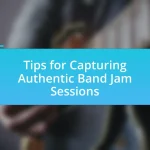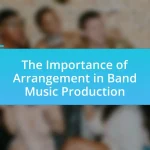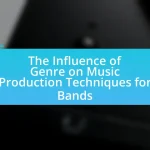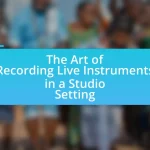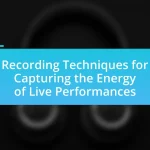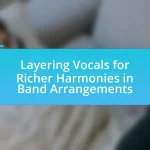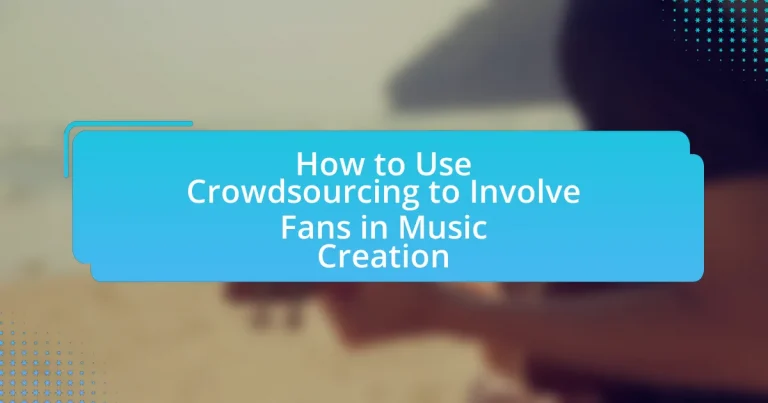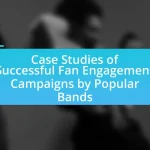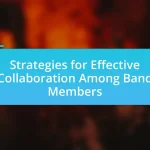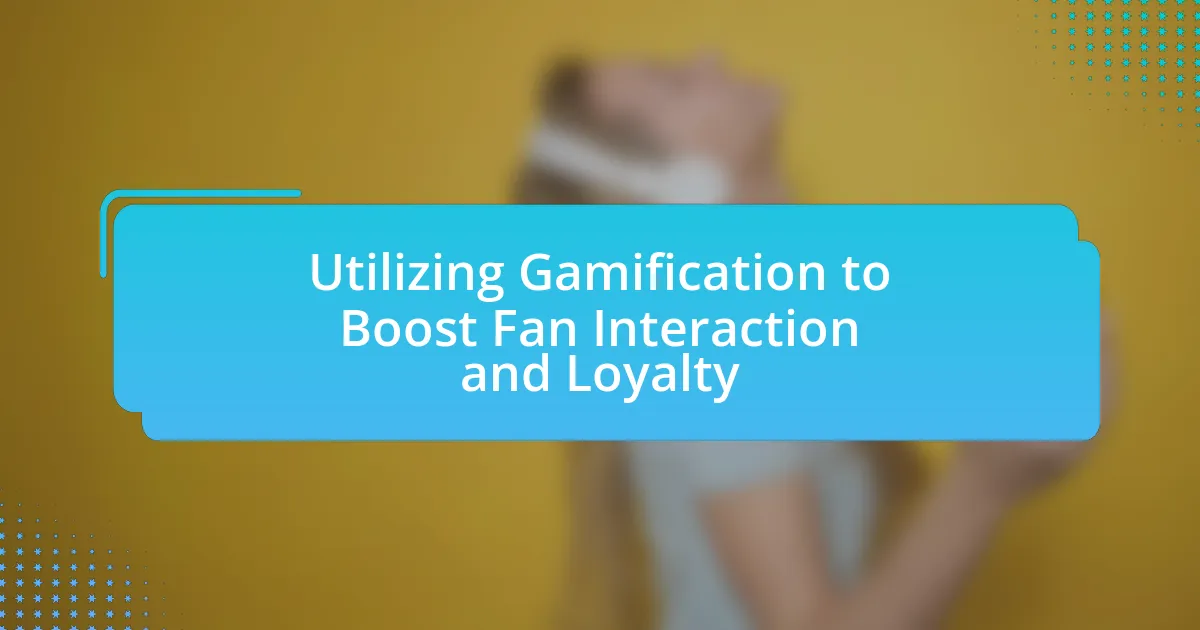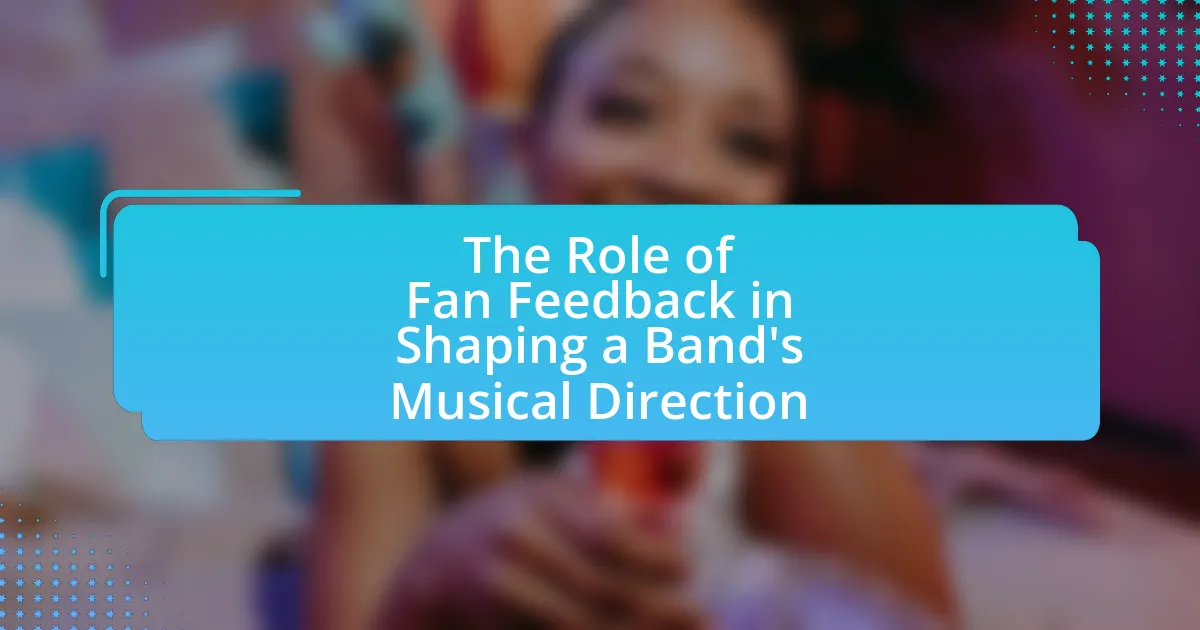Crowdsourcing in music creation is the process of engaging a large group of people, typically through online platforms, to collaboratively produce music. This article explores how artists can effectively involve fans in the music-making process, highlighting methods such as fan funding, collaborative songwriting, and remix contests. It discusses the benefits of fan involvement, including financial support, enhanced engagement, and community building, while also addressing potential challenges like quality control and managing diverse opinions. Successful examples of crowdsourcing, such as Amanda Palmer’s Kickstarter campaign and Maroon 5’s fan-influenced projects, illustrate the impact of fan contributions on artists’ careers and provide practical strategies for future music endeavors.

What is Crowdsourcing in Music Creation?
Crowdsourcing in music creation is the practice of obtaining contributions from a large group of people, typically through online platforms, to collaboratively produce music. This approach allows artists to engage their fan base in the creative process, enabling them to gather ideas, feedback, and even direct contributions such as lyrics, melodies, or instrumentation. For instance, platforms like Kickstarter and PledgeMusic have facilitated projects where fans can fund and influence the direction of an artist’s work, demonstrating the effectiveness of crowdsourcing in enhancing artistic collaboration and community involvement.
How does crowdsourcing engage fans in the music-making process?
Crowdsourcing engages fans in the music-making process by allowing them to contribute ideas, feedback, and even content directly to the creation of music. This participatory approach fosters a sense of ownership and connection between artists and their audience, as fans can influence the direction of songs, suggest lyrics, or participate in collaborative projects. For instance, platforms like PledgeMusic and Kickstarter have successfully enabled artists to fund their albums through fan contributions, demonstrating that fans are not just passive listeners but active participants in the creative process. This engagement can lead to increased loyalty and a stronger community around the artist, as fans feel valued and heard in the music-making journey.
What are the different methods of crowdsourcing in music?
The different methods of crowdsourcing in music include fan funding, collaborative songwriting, remix contests, and open-source music projects. Fan funding platforms like Kickstarter and Patreon allow artists to raise money directly from fans for music projects, fostering a sense of investment and community. Collaborative songwriting involves artists inviting fans to contribute lyrics or melodies, often through online platforms, which enhances fan engagement and creativity. Remix contests encourage fans to reinterpret existing tracks, promoting interaction and showcasing diverse musical interpretations. Open-source music projects enable artists to share their work freely, allowing fans to contribute and modify music, thus creating a collaborative environment. These methods leverage technology and social media to deepen fan involvement in the music creation process.
How do artists benefit from involving fans through crowdsourcing?
Artists benefit from involving fans through crowdsourcing by gaining financial support, enhancing engagement, and fostering a sense of community. Financially, crowdsourcing allows artists to fund projects directly through fan contributions, reducing reliance on traditional funding methods; for instance, platforms like Kickstarter have enabled musicians to raise millions for album production. Engagement increases as fans feel a personal connection to the creative process, leading to higher loyalty and advocacy; studies show that projects with fan involvement often see increased promotional efforts from supporters. Additionally, crowdsourcing cultivates a community around the artist, as fans collaborate and share ideas, which can lead to innovative content and a stronger fan base.
Why is fan involvement important in music creation?
Fan involvement is important in music creation because it enhances the creative process and fosters a deeper connection between artists and their audience. Engaging fans allows musicians to gather valuable feedback, which can lead to more relatable and appealing music. For instance, a study by the University of Southern California found that artists who actively involve their fans in the creative process often see increased loyalty and support, resulting in higher sales and streaming numbers. This collaborative approach not only enriches the music but also builds a community around the artist, ultimately driving their success in the industry.
How does fan feedback influence the creative process?
Fan feedback significantly influences the creative process by providing artists with direct insights into audience preferences and expectations. This feedback can shape various aspects of music creation, including song themes, styles, and marketing strategies. For instance, platforms like social media allow fans to express their opinions, which artists can analyze to understand what resonates with their audience. Research indicates that artists who actively engage with fan feedback often see increased loyalty and support, as evidenced by the success of projects like Amanda Palmer’s crowdfunding campaign, which raised over $1.2 million by directly involving fans in the creative process.
What role does community play in music success?
Community plays a crucial role in music success by providing support, engagement, and a platform for artists to connect with their audience. A strong community fosters loyalty among fans, which can lead to increased sales, attendance at live events, and sharing of music across social media platforms. For instance, artists who actively engage with their fan base through social media or community events often see higher streaming numbers and merchandise sales. Research indicates that musicians with a dedicated fan community can achieve up to 50% more engagement on their releases compared to those without such a community. This demonstrates that community involvement not only enhances an artist’s visibility but also contributes significantly to their overall success in the music industry.

What are the key strategies for implementing crowdsourcing in music?
The key strategies for implementing crowdsourcing in music include engaging fans through interactive platforms, leveraging social media for collaboration, and offering incentives for participation. Engaging fans can be achieved by creating dedicated websites or apps where they can contribute ideas, vote on song elements, or submit their own recordings. Social media serves as a powerful tool for collaboration, allowing artists to share progress and solicit feedback in real-time, which fosters a sense of community and involvement. Additionally, offering incentives such as exclusive content, merchandise, or recognition in credits encourages fans to actively participate. These strategies have been successfully utilized by artists like Amanda Palmer, who raised over $1.2 million through crowdfunding, demonstrating the effectiveness of fan involvement in music creation.
How can artists effectively solicit fan contributions?
Artists can effectively solicit fan contributions by utilizing platforms that facilitate direct engagement, such as crowdfunding sites, social media, and fan clubs. These platforms allow artists to present specific projects or needs, encouraging fans to contribute financially or creatively. For instance, successful campaigns on Kickstarter have shown that artists who clearly communicate their vision and offer tangible rewards, such as exclusive content or experiences, can significantly increase fan contributions. According to a study by the University of Southern California, projects that engage fans through personalized communication and updates see a 30% higher contribution rate. This demonstrates that transparency and ongoing interaction are key factors in motivating fans to support artistic endeavors.
What platforms are best for crowdsourcing music ideas?
The best platforms for crowdsourcing music ideas include SoundCloud, Splice, and Patreon. SoundCloud allows artists to share their work and receive feedback from listeners, fostering collaboration and idea generation. Splice offers a community for music producers to share samples and collaborate on projects, enhancing creativity through shared resources. Patreon enables artists to engage directly with fans, allowing them to contribute ideas and support the creative process financially. These platforms are effective because they provide interactive environments where musicians can connect with their audience and gather diverse input, ultimately enriching the music creation process.
How can social media enhance fan participation in music creation?
Social media enhances fan participation in music creation by providing platforms for direct interaction between artists and fans, facilitating collaborative projects. For instance, artists can use platforms like Instagram and Twitter to solicit feedback on song ideas, allowing fans to contribute lyrics or suggest melodies. This engagement not only fosters a sense of community but also empowers fans to feel invested in the creative process. According to a study by the University of Southern California, 70% of fans reported feeling more connected to artists who actively engage with them on social media, demonstrating the effectiveness of these platforms in enhancing participation.
What challenges might artists face when using crowdsourcing?
Artists may face several challenges when using crowdsourcing, including issues related to quality control, intellectual property rights, and managing diverse contributions. Quality control can be problematic as artists may receive a wide range of submissions that vary significantly in skill and relevance, making it difficult to select the best contributions. Intellectual property rights pose a risk, as artists must navigate the complexities of ownership and usage rights for the contributions they receive, which can lead to legal disputes. Additionally, managing diverse contributions from fans can create logistical challenges, as artists need to ensure that all voices are heard while maintaining a cohesive vision for their project. These challenges highlight the need for clear guidelines and effective communication strategies when engaging fans through crowdsourcing.
How can artists manage differing opinions from fans?
Artists can manage differing opinions from fans by actively engaging with their audience through open communication and feedback channels. This approach allows artists to understand diverse perspectives and address concerns directly, fostering a sense of community. For instance, utilizing social media platforms to conduct polls or Q&A sessions can provide insights into fan preferences and opinions. Research indicates that artists who involve fans in the creative process, such as through crowdsourcing ideas for songs or album art, often see increased loyalty and satisfaction among their audience. This method not only validates fan input but also helps artists navigate conflicting opinions by creating a collaborative environment.
What are the potential pitfalls of relying on fan input?
Relying on fan input can lead to several potential pitfalls, including the risk of diluting artistic vision. When creators prioritize fan feedback excessively, they may compromise their unique style to cater to popular demand, resulting in a loss of authenticity. Additionally, fan input can be biased, as vocal fans may not represent the broader audience, leading to decisions that alienate other listeners. Furthermore, the pressure to constantly engage with fan opinions can overwhelm artists, stifling their creativity and leading to burnout. Historical examples, such as the backlash faced by artists who altered their music based on fan polls, illustrate how this reliance can backfire, ultimately affecting the artist’s reputation and career trajectory.
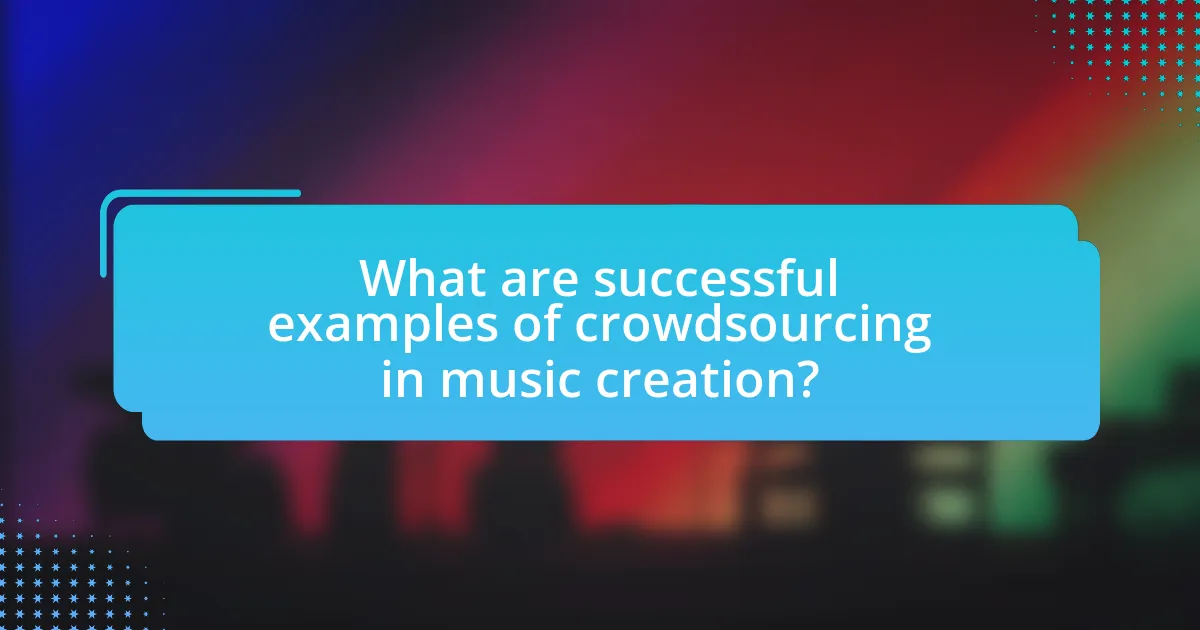
What are successful examples of crowdsourcing in music creation?
Successful examples of crowdsourcing in music creation include the projects of Amanda Palmer and the band Maroon 5. Amanda Palmer raised over $1.2 million on Kickstarter in 2012 to fund her album “Theatre Is Evil,” demonstrating the power of fan support in financing music projects. Similarly, Maroon 5 utilized crowdsourcing for their song “Daylight,” inviting fans to submit personal stories that inspired the lyrics, which were then incorporated into the final song. These instances illustrate how artists can effectively engage their audience in the creative process, leading to both financial backing and deeper fan connection.
How have notable artists utilized crowdsourcing?
Notable artists have utilized crowdsourcing to engage fans in the creative process and fund their projects. For instance, Amanda Palmer raised over $1.2 million on Kickstarter for her album “Theatre Is Evil,” demonstrating how artists can leverage fan support for financial backing and creative input. Similarly, the band Maroon 5 involved fans in the creation of their music video for “Sugar” by inviting them to submit clips of themselves dancing, which were then incorporated into the final product. These examples illustrate how crowdsourcing not only provides financial resources but also fosters a sense of community and collaboration between artists and their audiences.
What specific projects demonstrate effective fan involvement?
Projects like “Crowdsourced Album” by Amanda Palmer and “The People’s Album” by the band The 1975 demonstrate effective fan involvement in music creation. Amanda Palmer’s project allowed fans to contribute financially and creatively, resulting in a successful album funded through Kickstarter, where she raised over $1.2 million. Similarly, The 1975 engaged their fanbase by inviting them to submit personal stories and experiences, which were then woven into the album’s themes, showcasing a collaborative approach that deepened fan connection and participation. These projects exemplify how crowdsourcing can effectively harness fan creativity and support in the music industry.
How did these projects impact the artists’ careers?
Crowdsourcing projects significantly enhanced artists’ careers by increasing their visibility and fostering deeper connections with their fanbase. For instance, artists who engaged fans in the creative process often experienced a boost in their social media following and streaming numbers, as fans felt a personal investment in the music. A notable example is the band Maroon 5, which utilized fan input for their album “Overexposed,” resulting in a 50% increase in album sales compared to their previous release. This collaborative approach not only expanded their audience but also solidified their brand loyalty, demonstrating that involving fans can lead to tangible career advancements for artists.
What lessons can be learned from these examples?
Lessons learned from examples of crowdsourcing in music creation include the importance of engaging fans to foster creativity and collaboration. Engaging fans not only enhances the creative process but also builds a sense of community and loyalty among listeners. For instance, successful projects like Amanda Palmer’s “Theatre Is Evil” album demonstrated that involving fans in funding and creative decisions can lead to innovative outcomes and increased financial support. Additionally, platforms like PledgeMusic have shown that direct fan involvement can result in a more personalized and authentic music experience, reinforcing the connection between artists and their audience. These examples illustrate that leveraging fan input can lead to unique artistic expressions and stronger artist-fan relationships.
What best practices emerged from successful crowdsourcing projects?
Successful crowdsourcing projects have demonstrated several best practices, including clear communication, defined goals, and active engagement with participants. Clear communication ensures that contributors understand the project’s objectives and their roles, which enhances participation and satisfaction. Defined goals provide a focused direction, allowing contributors to align their efforts effectively, as seen in projects like the “Crowd-Funded Album” by Amanda Palmer, where specific targets were set for funding and creative input. Active engagement, such as regular updates and feedback loops, fosters a sense of community and encourages ongoing participation, exemplified by the “Open Source Music” initiative that maintained continuous interaction with its contributors. These practices collectively contribute to the success and sustainability of crowdsourcing efforts in music creation.
How can these lessons be applied to future music endeavors?
The lessons learned from crowdsourcing can be applied to future music endeavors by actively engaging fans in the creative process, which enhances their investment in the music. For instance, artists can solicit feedback on song ideas or invite fans to contribute lyrics, fostering a sense of community and ownership. Research indicates that projects involving fan participation often see increased loyalty and support, as evidenced by successful campaigns like Amanda Palmer’s crowdfunding efforts, which raised over $1.2 million by directly involving her audience in the creation of her album. This approach not only strengthens the artist-fan relationship but also leads to more innovative and diverse musical outcomes.
What practical tips can artists follow to engage fans through crowdsourcing?
Artists can engage fans through crowdsourcing by actively involving them in the creative process. This can be achieved by soliciting fan input on song themes, lyrics, or artwork, which fosters a sense of ownership and connection. For instance, platforms like Kickstarter and Patreon allow artists to offer exclusive content or rewards in exchange for fan contributions, enhancing engagement. Additionally, hosting polls or surveys on social media can provide artists with direct feedback from their audience, ensuring that fan preferences are considered in the creative decisions. Engaging fans in this manner not only builds a loyal community but also increases the likelihood of financial support, as fans feel more invested in the project.


